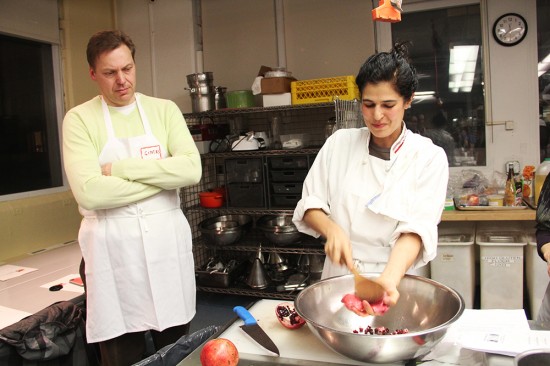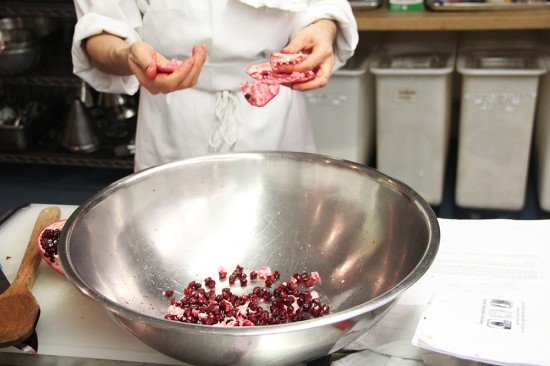I find eating a plant-based diet extremely rewarding, but I’ll be the first to admit that it is especially challenging to do so during the colder months. Eating a raw crunchy salad never seems to sufficiently warm me up after a long commute through freezing puddles and heavy winds.
However, after taking ICE’s Five-Course Winter Vegan Dinner class with Chef Louisa Shafia, author of the IACP nominated Lucid Food: Cooking for an Eco-Conscious Life and The New Persian Kitchen, I have found that vegan cuisine can be just as warming as the heartiest of meat dishes.

Louisa’s passion for Persian and Iranian cuisine, coupled with her love of produce-driven and eco-friendly cuisine, was evident in the recipes she chose for our class. All of the dishes were varied in texture, vibrant in color and so delicious that there was no need to include fake meats and dairy substitutes. For those with an interest in adding meat, however, Chef Shafia mentioned that animal proteins typically used in Persian-Iranian cuisine could easily be worked into any of the recipes we made.

Exploring unfamiliar ingredients is always my favorite part of any cooking class, especially those used in vegan and international dishes. My first encounter with tamarind paste was unforgettable. Blended with beet juice, this tangy-sweet mixture formed the Tamarind Beet Glaze, which we drizzled over the breaded Chickpea Cakes. I also tasted dulse – a reddish-brown, protein-packed sea plant – for the first time. Using tongs, this moist and chewy plant was quickly passed over the burner’s flame until lightly toasted. We then added it as a garnish on our Red Cabbage, Apple and Dulse Salad.

Perhaps the strangest ingredient I encountered was agar-agar powder—a clear, tasteless substance that originates from sea vegetables and is also known as “kanten”. When mixed with water, it becomes a thickening agent for fruit, pies and jams, like gelatin. This formed the base of our Pear Kanten with Pecan Crunch dessert.

Cooking ingredients from scratch often comes with labor-intensive preparations, but by learning the proper skills and techniques, it doesn’t have to be a chore. Chef Louisa took time to show us the various qualities of agar-agar powder, as well as how to break down an enormous, stubborn butternut squash, which we roasted for the Mediterranean Shepherd’s Pie. We also learned how to cut open a pomegranate without squirting its red juice all over the kitchen (cut the fruit in half and whack the back of it with a wooden spoon; the seeds drop out effortlessly).

Pomegranate proved to be the star ingredient in this class, finding a home in nearly every recipe we made. It became a delicious garnish, when paired with cilantro, for my favorite dish of the night—the pomegranate soup. Rich in color, spices, legumes and of course, pomegranates, this soup ended my search for a wholesome, warming vegan dish. I loved it so much, I asked Chef Louisa to share the recipe with you. I encourage you to try making this at home as cool weather lingers in these early spring months.

Ingredients
- 3 tablespoons grapeseed oil
- 1 yellow onion, diced
- 2 cloves garlic, minced
- ¾ cup split peas
- ½ cup lentils
- ½ cup dried mung beans
- ½ cup pearled barley
- 1 large beet, peeled and diced small
- 1 teaspoon turmeric
- 2 teaspoons ground cumin
- 12 cups vegetable stock or water
- ½ cup pomegranate molasses
- 1 bunch cilantro, coarsely chopped
- Sea salt and freshly ground black pepper
- Seeds of 1 pomegranate
Directions
- To make the soup, heat the oil in a large stockpot over medium heat and cook the onion for about 10 minutes until it starts to brown. Add the garlic, split peas, lentils, mung beans, barley, beet, turmeric, cumin, and stock, and bring to a boil. Lower the heat and simmer, partially covered, for about 1½ hours, until the beans and barley are tender and the soup is slightly thickened.
- Add the pomegranate molasses to the soup. Season with salt and pepper, and stir in the cilantro. Ladle into bowls and garnish with the pomegranate seeds.
Reprinted with permission from The New Persian Kitchen by Louisa Shafia, copyright © 2013. Published by Ten Speed Press, a division of Random House, Inc.



